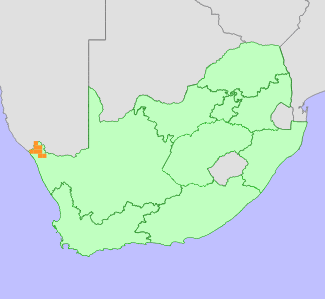|
Scientific Name | Conophytum jucundum (N.E.Br.) N.E.Br. subsp. jucundum |
Higher Classification | Dicotyledons |
Family | AIZOACEAE |
Synonyms | Conophytum admiraalii L.Bolus, Conophytum geyeri L.Bolus, Conophytum gratum (N.E.Br.) N.E.Br. (in part), Conophytum gratum (N.E.Br.) N.E.Br. subsp. gratum, Conophytum jacobsenianum Tischer, Conophytum jucundum (N.E.Br.) N.E.Br., Conophytum longistylum N.E.Br., Conophytum maximum Tischer, Conophytum orbicum N.E.Br. ex Tischer, Conophytum praegratum Tischer, Conophytum rarum N.E.Br., Conophytum robustum Tischer, Mesembryanthemum gratum N.E.Br., Mesembryanthemum jucundum N.E.Br. |
National Status |
Status and Criteria | Endangered A4d |
Assessment Date | 2021/11/30 |
Assessor(s) | A.J. Young, P.G. Desmet, I. Ebrahim, D. Guo, A. Harrower, L. Jabar, L. Knoetze, C. Rodgerson & P.C.V. Van Wyk |
Justification | This succulent is endemic to the Karas region of Namibia and the Northern Cape province of South Africa with an extent of occurrence (EOO) of 3,648 km² and area of occupancy (AOO) of 96 km². The population is in decline due to illegal collection for the ornamental succulent plant trade, with collection likely to increase as there has been a dramatic increase in the number of species and volume of plants targeted since 2019. The scattered distribution of the plants across a remote and sometimes inaccessible landscape in combination with uncertainty of how this plant will respond to climate change means a decline of 50% of the population is suspected over the next three generations (90 years). It therefore qualifies as Endangered under criterion A4. |
Distribution |
Endemism | Not endemic to South Africa |
Provincial distribution | Northern Cape |
Range | This succulent is only found in the Richtersveld region of the Northern Cape province of South Africa and the Karas region of southwestern Namibia. |
Habitat and Ecology |
Major system | Terrestrial |
Major habitats | Desert, Succulent Karoo |
Description | This dwarf succulent is restricted to the Desert and Succulent Karoo biomes, endemic to the Richtersveld and Gariep Desert bioregions. Plants occupy patches of quartz and gneiss, often on rough ground at altitude. The plants are often seen in the partial shade of large rocks or other vegetation. This taxon has a generation length of 30 years. It is expected to be sensitive to the impacts of climate change as it does not disperse and while adapted to arid conditions, is dependent on limited seasonal rainfall. Species in the genus are sensitive to long periods of drought. Drought related mortality has been observed for other closely related taxa within the genus. |
Threats |
| This succulent has been subject to illegal collection for the international trade in ornamental succulents, with more than 1,000 individuals (identified to species level only) confiscated from poachers since 2019. Most of the individual subspecies are challenging to distinguish from each other and it is almost certain that this particular taxon has been collected in high numbers. This is likely to increase in future as there has been a dramatic increase in the number of species and volume of plants targeted since 2019. Anthropogenic climate change is a long-term threat to this succulent. Loss of vegetation cover has been observed across the geographic range occupied by this taxon via Landsat imagery between 1984 and 2018 indicating a decline in habitat quality. Climate models for the likely emission scenarios where emissions stay at present day levels (RCP 2.6) (Hausfather and Peters 2020) and worst case scenarios where emissions continue to increase during the 21st century (RCP 8.5) indicate that there will be a loss of suitable bioclimatic envelope of between 65% and 99% by 2080 for this succulent. However, as this taxon possesses certain traits likely to afford resilience to xerophytic conditions it is expected to have a level of resilience to climate change and the expected population loss is reduced by 20% to 45%. Species in this genus have limited dispersal ability and migration to suitable habitats elsewhere is regarded as highly unlikely. |
Population |
This succulent is known from numerous locations where it it may be locally common or abundant. There are no formal estimates of population size but is likely to be well in excess of 200,000 mature individuals. However, in response to an extended drought in the Richtersveld that started in 2016 and is still ongoing at the time of assessment and illegal collection, the population is suspected to be declining.
|
Population trend | Decreasing |
Assessment History |
Taxon assessed |
Status and Criteria |
Citation/Red List version | | Conophytum jucundum (N.E.Br.) N.E.Br. subsp. jucundum | Least Concern | Raimondo et al. (2009) | |
Bibliography |
Hammer, S. 2002. Dumpling and his wife: New view of the genus Conophytum. EAE Creative Colour, Norwich.
Hammer, S.A. 1993. The genus Conophytum: A conograph. Succulent Plant Publications, Pretoria.
Hausfather, Z. and Peters, G.P. 2020. Emissions - the 'business as usual' story is misleading. Nature 577(618-620).
Opel, M.R. 2004. The rediscovery of Crassula alcicornis. Haseltonia 10:38-40.
|
Citation |
| Young, A.J., Desmet, P.G., Ebrahim, I., Guo, D., Harrower, A., Jabar, L., Knoetze, L., Rodgerson, C. & Van Wyk, P.C.V. 2021. Conophytum jucundum (N.E.Br.) N.E.Br. subsp. jucundum. National Assessment: Red List of South African Plants version 2024.1. Accessed on 2025/11/07 |
 Comment on this assessment
Comment on this assessment


